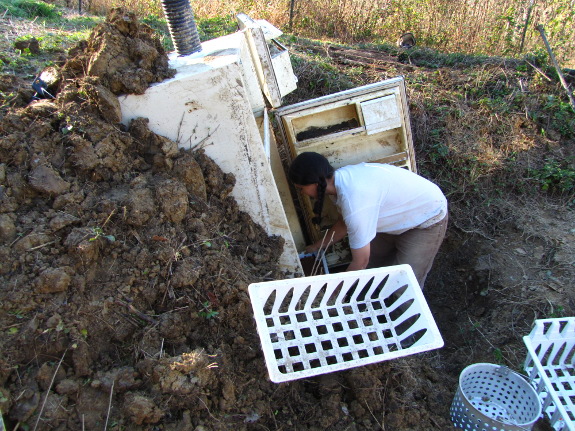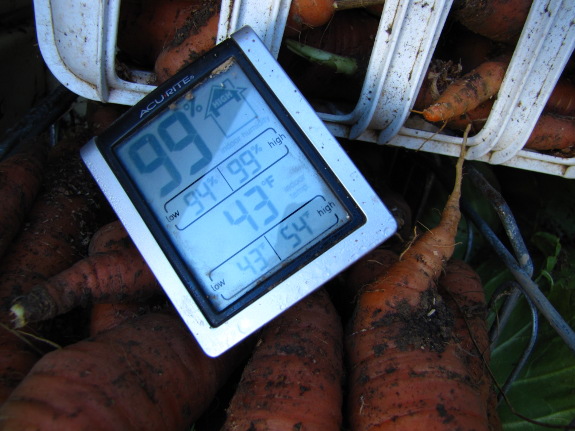
Pros and cons of a fridge root cellar

This is a very timely
comment because many of you are probably trying to figure out what to do
with all of those root crops (and fall fruits). I'll hit the
highlights in this post, but if you want to dig deeper, I've also set my ebook version
on sale to $1.99 this week so you can learn the rest of the story for
very little cash. (I guess that would turn your replica into a $12
root cellar?) And while you're over there, you'll probably want to snap up Low-Cost Sunroom, which is free today!

Anyhow, back to the
point. The advantages of our fridge root cellar are pretty
obvious. It was cheap and easy to build and it really works.
I particularly love how accessible the contents are --- the cook in
your family will be thrilled to be able to just pop open the door like
you would in a powered refrigerator and remove a few carrots or a head
of cabbage. And the dampness of the earth means that your roots
stay crisp and delicious for months after harvest.
 The downsides are relatively minor, but they are
present. We use a very small amount of electricity to ensure that
the contents of our fridge root cellar don't freeze when outside
temperatures drop below the mid-teens Fahrenheit. If you lived in
Alaska, you'd probably have to do a lot more. And a fridge root
cellar won't do much during the summer months, so you'll need a different
storage method for your spring carrots. (I just stick them in the
real fridge inside.) Finally, youtube viewers
will call you white trash if you post a video showing how to build a
fridge root cellar, and your neighbors might feel the same way, so this
project is not for the thin-skinned.
The downsides are relatively minor, but they are
present. We use a very small amount of electricity to ensure that
the contents of our fridge root cellar don't freeze when outside
temperatures drop below the mid-teens Fahrenheit. If you lived in
Alaska, you'd probably have to do a lot more. And a fridge root
cellar won't do much during the summer months, so you'll need a different
storage method for your spring carrots. (I just stick them in the
real fridge inside.) Finally, youtube viewers
will call you white trash if you post a video showing how to build a
fridge root cellar, and your neighbors might feel the same way, so this
project is not for the thin-skinned.
I hope that helps you
make your fridge-root-cellaring decision! And I'd love to see some
reader photos of your own incarnations of the cheap root-storage device
if anyone's given our method (or something related) a try. Email me at anna@kitenet.net
and I'll share your root cellars with our readers (and maybe even add
them to the next edition of the book if they're unique enough!).
Want more in-depth information? Browse through our books.
Or explore more posts by date or by subject.
About us: Anna Hess and Mark Hamilton spent over a decade living self-sufficiently in the mountains of Virginia before moving north to start over from scratch in the foothills of Ohio. They've experimented with permaculture, no-till gardening, trailersteading, home-based microbusinesses and much more, writing about their adventures in both blogs and books.
Want to be notified when new comments are posted on this page? Click on the RSS button after you add a comment to subscribe to the comment feed, or simply check the box beside "email replies to me" while writing your comment.

Anyone who calls someone who is living self-sufficiently "white trash" is brain dead and doesn't deserve to be paid any attention to!
Unfortunately my property is fairly flat and so I have no way of mounding up dirt around a fridge.
Hi Anna and Mark,
I wonder if your 'fridge' has any kind of vent? ( To keep things from getting musty.) Slightly leaky gaskets, etc. would work very well.
Some 'clamps' (as in pile of dirt) used for produce storage have a chimney.
As far as I can tell this is to keep air moving slowly, probably VERY slowly through the stored produce.
And thus help keep the produce 'fresh'.
I assume the effect it to vent the few spores that escape from the stored produce?
I keep dead refrigerators for use also :).
John
I agree with Nayan! There's nothing better than giving new life to throwaways.
Our homemade "root cellar" is different from yours, but also recycled. We put an old metal utility shelf unit in our crawl space (which has been dug out to make it possible to stand down there). But because we have a major field mouse problem, we had to make the storage space inaccessible to those varmints. We wrapped the unit with hardware cloth, latching it on one side so we could open it. To make it really rodent proof, we bent the top edge over the top shelf and weighted it down with heavy paint cans. On the bottom edge, we bent the hardware cloth and clamped it with binder clips. (Hard to visualize--harder to explain--but it works.) It's not as big a space as we need, but it's been adequate for potatoes and winter squash. And it really has kept the mice at bay!